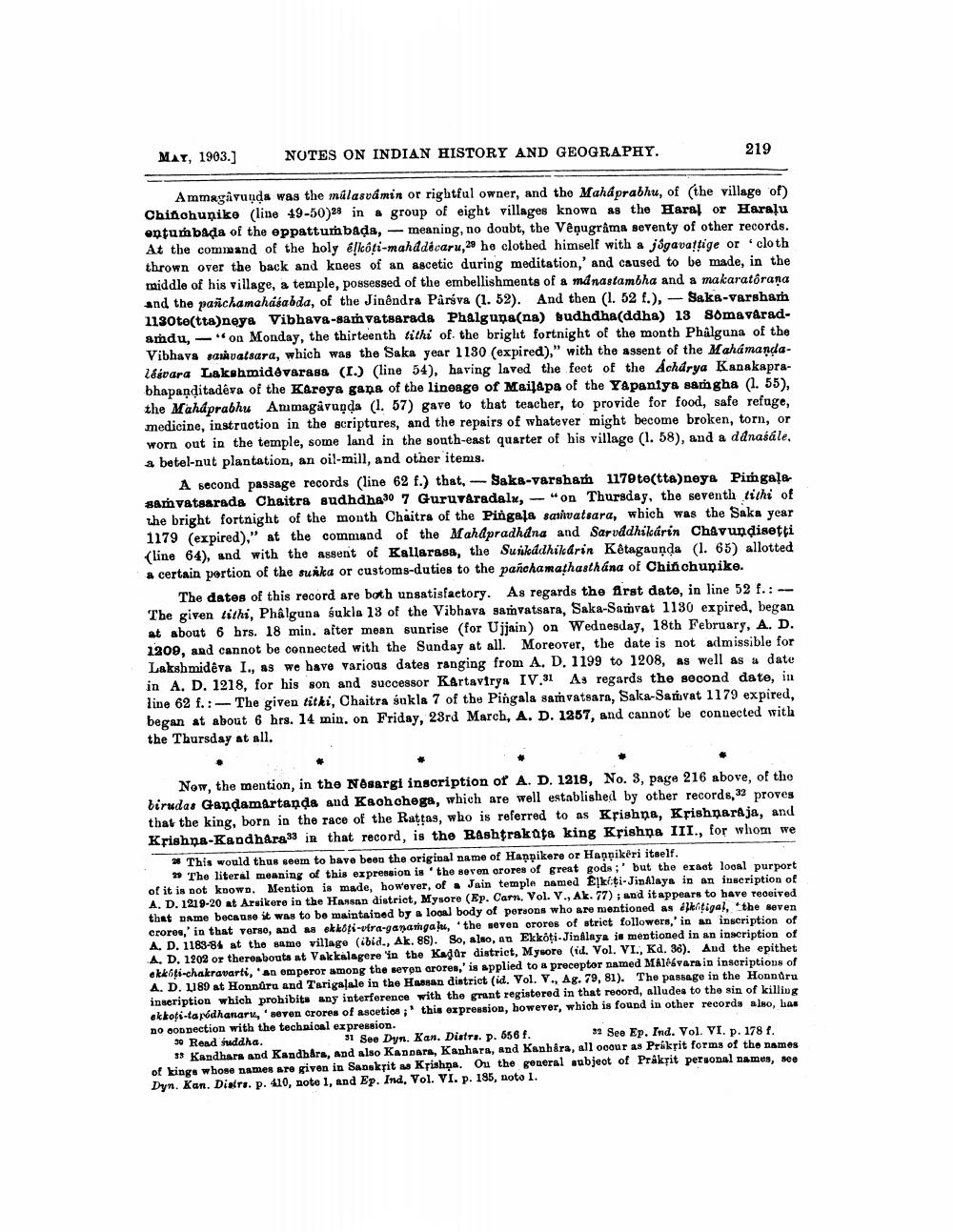________________
Mar, 1903.]
NOTES ON INDIAN HISTORY AND GEOGRAPHY.
219
Ammagavuuda was the malasvá min or rightful owner, and tho Maháprabhu, of (the village of) Chinchuņike (line 49-50)28 in a group of eight villages know as the Haral or Haraļu ontumbada of the eppattumbada, - meaning, no doubt, the Vêņugrama seventy of other records. At the command of the holy é!lcóti-mahadevaru,29 he clothed himself with a jigavattige or cloth thrown over the back and knees of an ascetic during meditation,' and caused to be made, in the middle of his village, a temple, possessed of the embellishments of a manastambha and a makaratorana and the paschamahasabda, of the Jinêndra Paráva (1. 52). And then (1. 52 f.), - Saka-varsham 1130 te(tta)neys Vibhava-samvatsarada Phalguna(na) budhdha(ddha) 13 Somavaradamdu, -"on Monday, the thirteenth tithi of the bright fortnight of the month Phålguna of the Vibhava salavatsara, which was the Saka year 1130 (expired)," with the assent of the MahamandaL&svara Lakshmidevarass (1.) (line 54), having laved the feet of the Acharya Kanakaprabhapaņditadêva of the Koreya gana of the lineage of Mail&pa of the Yapaniya samgha (1. 55), the Maháprabhu Ammagávuņda (1. 57) gave to that teacher, to provide for food, safe refuge, medicine, instruction in the scriptures, and the repairs of whatever might become broken, torn, or worn out in the temple, some land in the south-east quarter of his village (1. 58), and a danasále, a betel-nut plantation, an oil-mill, and other itens.
A second passage records (line 62 f.) that, - Sake-varsham 1170 te(ttaneye Pimgala samvatsarada Chaitra sudhdha30 7 Guruváradalu, -"on Thursday, the seventh tithi of the bright fortnight of the month Chaitra of the Pingala saivatsara, which was the Saka year 1179 (expired)," at the command of the Mahápradhana and Sarvddhikarin Chevundisetti (line 64), and with the assent of Kallarasa, the Sunkddhikarin Ketagaunda (1. 65) allotted a certain portion of the suška or customs-duties to the panchamathasthana of Chinchuņike.
The dates of this record are both unsatisfactory. As regards the first dato, in line 52 f.: -- The given tithi, Phâlguna sukla 18 of the Vibhava samvatsara, Saka-Samvat 1130 expired, began at about 6 hrs. 18 min. after mean sunrise (for Ujjain) on Wednesday, 18th February, A. D. 1209, and cannot be connected with the Sunday at all. Moreover, the date is not admissible for Lakshmideva I., as we have various dates ranging from A, D, 1199 to 1208, as well as a date in A. D. 1218, for his son and successor Kertavirya IV.31 As regards the second date, in line 62 f.:-The given titki, Chaitra sukla 7 of the Pingala samvatsarn, Saka-Saravat 1179 expired, began at about 6 hrs. 14 min. on Friday, 23rd March, A. D. 1257, and cannot be connected with the Thursday at all.
Now, the mention, in the Nbsargi inscription of A. D. 1218, No. 3, page 216 above, of the birudas Gandamartanda and Kaoh chega, which are well established by other records, 32 proves that the king, born in the race of the Rattas, who is referred to as Kfishna, Krishnaraja, and Krishna-Kandhara 33 in that record, is the Rashtrakata king Krishna III., for whom we
* This would thus seem to bave been the original name of Happikere or Happikeri itself.
>> The literal meaning of this exprension is the seven crores of great gode ;' but the exact looal purport of it is not knowo. Mention is made, however, of Jain temple named Elkiţi-Jinalaya in an inscription of A. D. 1219-20 at Arsikere in the Hassan district, Mysore (Ep. Carn, Vol. V., Ak. 77), and it appears to have received that name because it was to be maintained by a loon) body of persons who are mentioned as étitigal, the seven crores,' in that verse, and as ekkoti-vfra-ganangalu, 'the seven orores of strict followers,' in an inscription of A. D. 1183-84 at the same village (ibid., Ak. 86). So, also, an Ekkoţi.Jinalaya is mentioned in an inscription of A. D, 1202 or thereabouts at Vakkelagere 'in the Kapur district, Mysore (id. Vol. VI., K. 38). And the epithet ekkoti-chakravarti, 'an emperor among the seven crores,' is applied to a preceptor named Malesvara in inseriptions of A. D. L180 at Honnüra and Tarigalale in the Hassan district (id. Vol. V., Ag. 79, 81). The passage in the Honnoru inscription which prohibits any interference with the grant registered in that record, alludea to the sin of killing okkoti-tapódhanaru, seven crores of asceties; this expression, however, which is found in other records also, bas no son nection with the technical expression. 30 Read fuddha. 31 Seo Dyn. Kan. Distrs. p. 656 f.
11 See Ep. Ind. Vol. VI. p. 178 4. * Kandhars and Kandhara, and also Kansara, Kanhara, and Kanhira, all ooour as Prakpit forms of the names of kings whose names are given in Sanskrit a Krishna. On the general subject of Prakrit personal names, no Dyn. Kan. Diss. p. 410, note 1, and Ep. Ind. Vol. VI. p. 185, noto 1.




